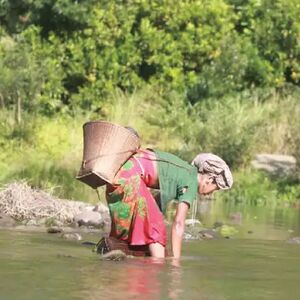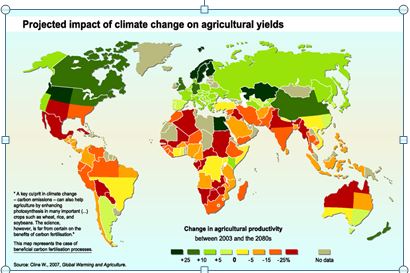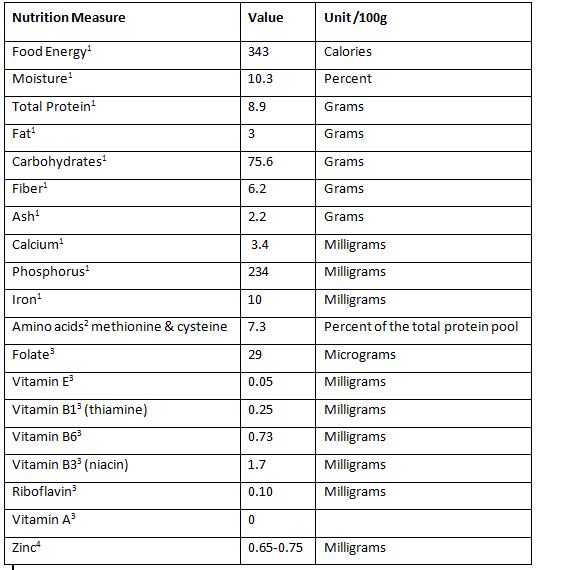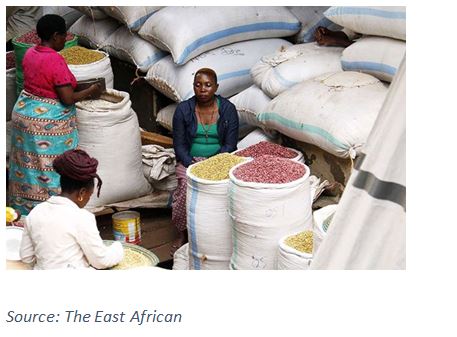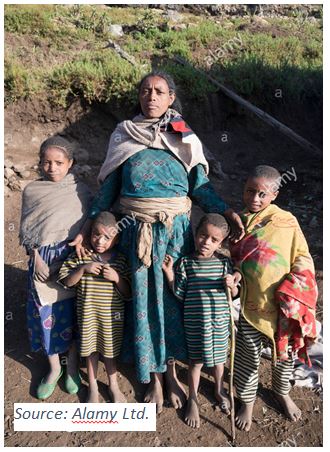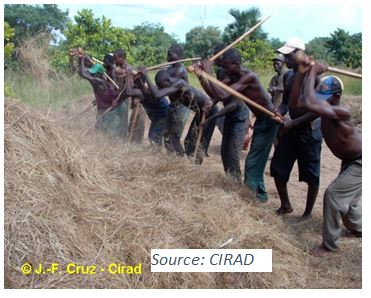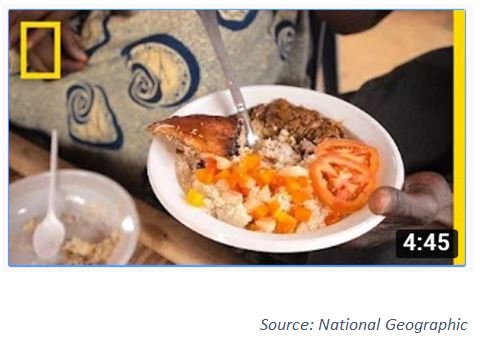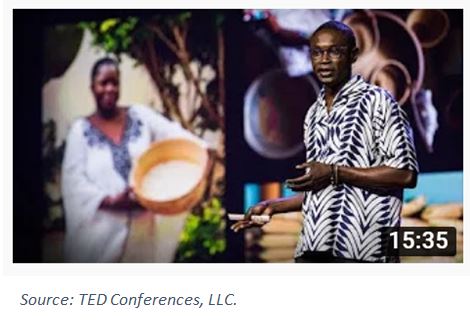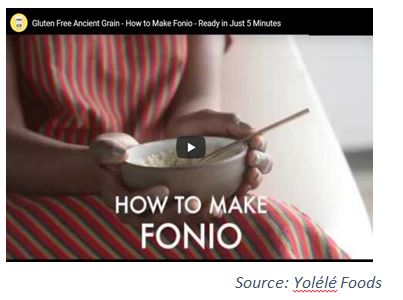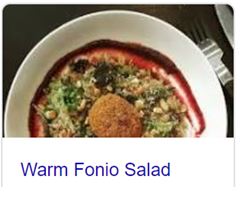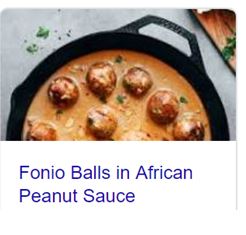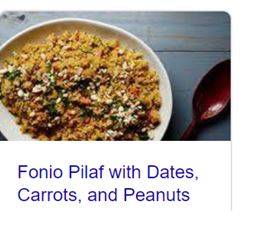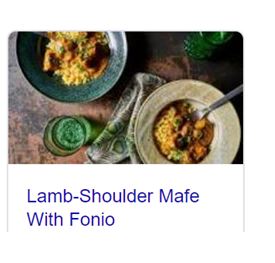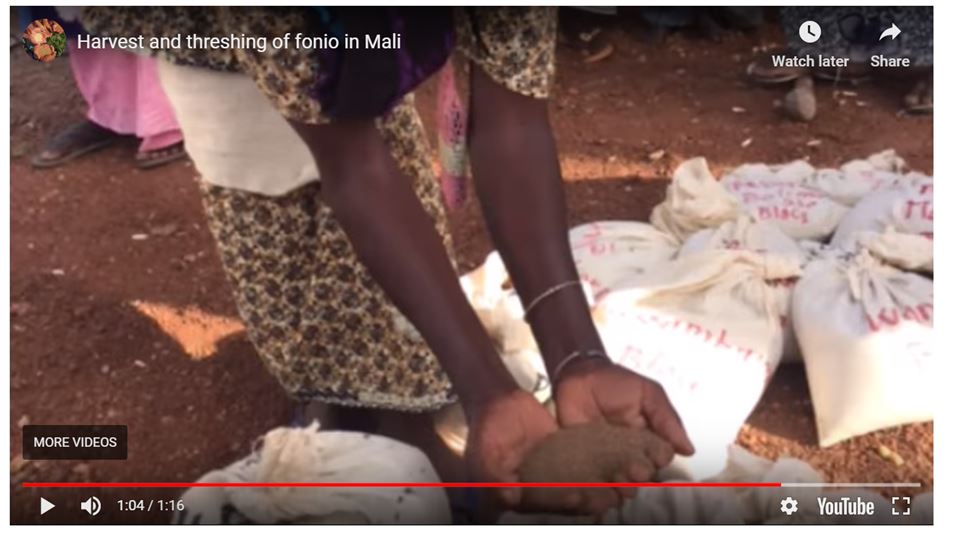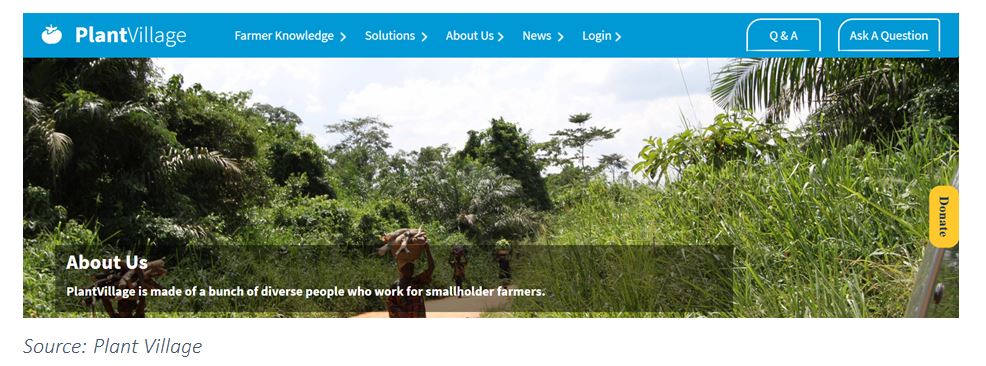Chapters 5.14
5.14 -Digitaria exilis: Fonio, Acha, Hungry Rice
Julie-Lynn Costigane , University of Guelph, Canada
Suggested citation for this chapter.
Costigane,J. (2022) Digitaria exilis: Fonio, Acha, Hungry Rice, In Farmpedia, The Encyclopedia for Small Scale Farmers. Editor, M.N. Raizada, University of Guelph, Canada. http://www.farmpedia.org
Introduction
Climate Change has had an adverse impact on agriculture in Africa and around the world (IPCC, 1990). Drought due to increased global temperatures is one of many effects of this environmental crisis (Muller, 2011). Many innovations have been developed in an effort to combat these negative impacts (Lybbert & Sumner, 2012).
The cultivation of fonio in Senegal and the Sahal strip of Africa is one of many promising opportunities to combat climate change (Morgan, 2018). Fonio is a millet grass with small grains that was domesticated by West Africans thousands of years ago (NRC, 1996).
There are two types of fonio (NRC, 1996). White fonio (Digitaria exilis) is commonly found in Senegal, Chad, Nigeria and surrounding areas (NRC, 1996). Black fonio (Digitaria iburua) in primarily cultivated in Togo and Benin’s northern regions, or Nigeria’s Jos-Bauchi Plateau (NRC, 1996). Increasing the cultivation of this crop in drought-affected regions is an effective and sustainable innovation that can uplift subsistence farmers and their communities (NRC, 1996). The crop’s fast maturation time, strong environmental tolerances, and superior nutritional qualities (compared to other African grains) are?,/p>
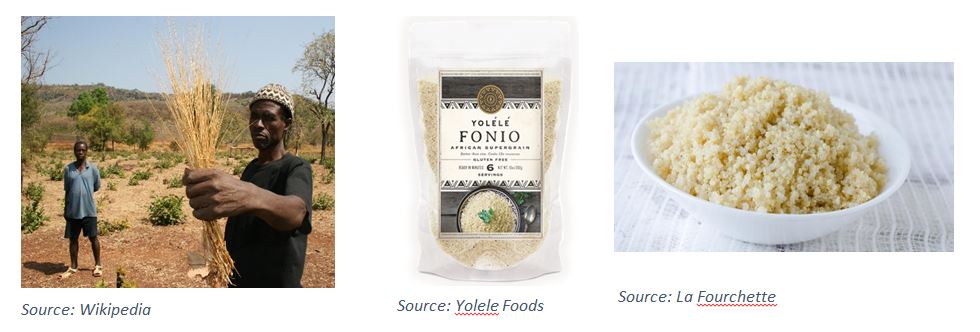
encouraging incentives for the expansion of its role in agriculture, economy, and international development (NRC, 1996).
The Crop
Fonio is used as a rotation crop, cultivated before and/or after maize, pearl millet, and/or sorghum (Adoukonou-Sagbadja et al, 2008). It is then harvested, threshed, dried for 3-4 days, and then can be stored for up to 5-10 years (Adoukonou-Sagbadja et al, 2008). In the United States, the retail cost for fonio is approximately $2 USD per ounce from Yolélé Foods International (Yolélé, 2019).
While fonio does respond well to fertilizer, lodging (blowing over) of the plant occurs due to the resulting increased stem growth combined with increased grain production, causing the plant to be top-heavy (NRC, 1996). The grain is adaptable to many soil types including poor, shallow soils, rocky soils and sandy, infertile soils than other cereal grains (NRC, 1996). Its large root system helps reduce soil erosion (Morgan, 2018). Thriving in rainfall between 250 mm and 1,500 mm), the plant is primarily cultivated in dry areas with >400 mm of rainfall but not in extreme drought environments (NRC, 2006). Fonio is usually farmed in areas with average temperatures between 25 and 30 ̊C – mainly tropical areas with rotating dry seasons (CIRAD, 2019) Only a few insect pests have been found on fonio (Kalaisekar, A., et al., 2017). These include grasshoppers, thrips, Atherigona spp. shoot flies and C. partellus stem borers (Kalaisekar, A., et al., 2017). Notably, fonio can be planted for a few years in order to reduce the pathogenic fungus M. phaseolina in soils where it normally infects cowpea (Mbaye et al., 2008).
The Fouta Djallon Plateau in Guinea and around the upper basins of the Senegal and Niger Rivers have vast landraces of fonio that can and should be included in germplasm collections such as seed banks (NRC, 1996). Germplasm collection and research can lead to improved cultivars, crop performance, market position of the crop and socioeconomic position of those that cultivate it (NRC, 1996). Seeds are stocked at L’Association Pour La Protection de la Nature, Shahel, in Djibo, Burkina Faso (Vernooy et al., 2015). Average fonio yields are low or comparable small cereal grains – but these yields are nevertheless low, but at least yield is possible under high heat and drought conditions.
Quantitative Information
Table 1: Yields of Common African Grains
Source: Lost Crops of Africa - Volume 1 (Grains)
Impressively, fonio is the fastest-maturing grain cereal (Kalaisekar et al., 2017). Maturation at 6 weeks is very quick compared to most other local crops (Cruz, 2004). This permits the consumption of key nutrients required to get a good start on planting during the Hunger Season, well before most other crops are harvested (WFP, 2019). It is important to note fonio’s very high amino acid content. 7.3% of the total protein pool is methionine & cysteine – amino acids that are scarce in other African cereal grains (NRC, 1996).
Table 2: Nutritional Values of Whole Grain Fonio
Sources:
1. Food and Agriculture Organization (FAO) of the United Nations (2019)
2. Biodiversity International (2019)
3. European Food Safety Authority (2018)
4: Adoukonou-Sagbadja, H., et al (2015)
Adoption by Small Scale Farmers
There are a number of ways in which small scale and subsistence farmers can adopt fonio into their existing agricultural infrastructure. For example, farmers can sell any surplus product at local market(s) and can catalyze food supply co-operatives between local farmers (Ortmann, 2010).
This addition of this alternative income source could greatly increase the family’s ability to send children to school, buy other seeds to intercrop and/or rotate with, healthcare, etc. (Mertz et al., 2005). Intercropping or rotating monocropping can include foxtail millet, fava beans, mung beans, and lentils (Loke et al, 2016). Not only can fonio be used to support and improve human nutrition, but its by-products can be used as animal feed (Fanou-Fogny, 2012). The crop is not perfect and has its disadvantages like all crops. Unfortunately, colonizers taught African people to frown upon their own local cultures and foods (Tham, 2019). Fonio has been viewed as “just country people’s food” and “substandard” according to locals (National Geographic, 2017). This may present a barrier to adoption by local farmers. Fortunately, the crop has a high socio-cultural value in Togo (Adoukonou-Sagbadja et al, 2008).
Production and post-harvest processing are labour-intensive, more-so for women than men (Adoukonou-Sagbadja et al, 2008). Improved harvesting efficiency requires specialty tools that are not easy to obtain (Adoukonou-Sagbadja et al, 2008). Additionally, fonio is a light and fluffy food so large quantities
need to be consumed (Morgan, 2018). Its small, spherical shape does not permit a tight packing order (Askeland & Wright, 2016). This results in fewer grains per cup. Fewer grains per cup means fewer nutrients per cup. Fonio has a low nutrient density when measured in weight per cooked volume. The technical definition of nutrient density measures this characteristic in weight percentage (g/100g), as seen above in Table 2: Nutritional Values of Whole Grain Fonio.
In terms of nutritional value, lentil is often called “poor man’s meat”, as it is high in protein (Samaranayaka, 2017). For 100g of cooked lentils there is 9g of protein and when it is combined with a whole grain such as millet, a complete source of protein (i.e. all essential amino acids) is consumed (FDA, n.d; USDA, 2019 ). The crop is also an excellent source of vitamins and minerals, including folate, iron and zinc (Urbano et al., 2007). Folate is especially important for children and pregnant women to consume, as it regulates growth (Johnson, 2018).
Resources
Fortunately, fonio’s potential has not been overlooked by all. National Geographic has created the inspiring short video “The Most Nutritious Grain You've Never Heard Of” It briefly introduces what fonio agriculture means to local economy and culture. It can be viewed at youtube.com/watch?v=X6mUY6FR234.
Pierre Thiam’s TED Talk entitled “A forgotten ancient grain that could help Africa prosper” also discusses cultural perceptions of the grain. His personal experience as a chef lends a unique perspective to the employability and future of the grain. His detailed analysis of fonio’s potential in current economic markets is encouraging. It can be viewed at youtube.com/watch?v=yjtCDgjxRAw.
Fonio is cooked the same way as quinoa – boiled until water is absorbed, then fluffed with a fork (Yolélé, 2019). An instructional video about how to prepare it can be viewed at youtu.be/1Vhl_SIAgn4 . It has a delicate taste and is very versatile (National Geographic, 2014). It can be easily substituted for any starch or grain in most dishes (National Geographic, 2014). Many
Source: Food 52 - food52.com/recipes/76808-warm-fonio-salad
Source: Full of Plants Tasty Vegan Recipes fullofplants.com/fonio-balls-african-peanut-sauce
Source: Saveur Magazine saveur.com/fonio-pilaf-with-dates-carrots-and-peanuts-recipe
Source: New York Times cooking.nytimes.com/recipes/1019191-lamb-shoulder-mafe-with-fonio
Agronomy
Source: NUS Community youtube.com/watch?v=M8oN9hFQeUE&feature=youtu.be
After roughly loosening the soil, the seeds are broadcast at a standard density of 30 kg of seed per hectare (Gijous et al., 2009 & Plant Village, 2019). The seeds are pressed into the soil before being lightly covered and permitted to germinate (Plant Village, 2019). Due to its quick seed germination time of only 3-4 days after sowing (Biodiversity International, 2018), it outcompetes weeds (Plant Village, 2019). Reduced weeding requirements drastically reduces the amount of labour for women (Enete et al, 2002). While crop upkeep and harvesting requires very low maintenance, harvest processing is labour intensive (Plant Village, 2019). The dried plants must be beaten repeatedly - threshed - in order to extract the tiny grains (Plant Village, 2019). The seeds require the same standard treatment to promote germination as all other seeds - damp darkness (Duke University, 2019). The dried grains should be stored like all other dried grains – in dry darkness (Whole Grains Council, 2019).
Existing Support Initiatives
Penn State University’s Plant Village is a research and development unit with an ambitious but practical mission which “empowers smallholder farmers and seeks to lift them out of poverty using cheap, affordable technology and democratizing the access to knowledge that can help them grow more food.” as per their website.
Resource Management
From an engineering project management perspective, any proposed project requires an extensive financial analysis (Fraser et al., 2016). A cost–benefit analysis of adopting fonio involves the following 10 steps:
1. Set the framework for the analysis.
2. Decide whose costs benefits should be recognized.
3. Identity and categorize costs and benefits.
4. Project costs and benefits over the life of the program.
5. Monetize costs.
6. Monetize benefits.
7. Discount costs and benefits to obtain present values.
8. Compute net present values.
9. Perform sensitivity analysis.
10. Make a recommendation. (Holquist, 2013)
The advantages and disadvantages of each innovation opportunity must be critically analysed in order to make the best use of limited project resources (Fraser et al., 2016). Overall, fonio boasts a number of opportunistic advantages that can make a significant impact on the lives of countless African people (NRC, 1996). Only sustainable initiatives can assist African farmers cultivate this crop long-term.
References
1. Adoukonou-Sagbadja, H., Dansi, A., Vodouhè, R., & Akpagana, K. (2008, February). Indigenous Knowledge and Traditional Conservation of Fonio Millet (Digitaria exilis, Digitaria iburua) in Togo. Topics in Biodiversity and Conservation Human Exploitation and Biodiversity Conservation, 39–55. doi: 10.1007/978-1-4020-5283-5_4
2. Alamy Limited. (2019). Farmer Africa Family Stock Photos and Images. Retrieved from https://www.alamy.com/stock-phot2019o/farmer-africa-family.html.
3. Askeland, D. R., & Wright, W. J. (2016). The Science and Engineering of Materials (7th ed.). Boston, MA: Cengage Learning.
4. Biodiversity International. (2018). Neglected and Underutilized Species Community. Retrieved from http://www.nuscommunity.org/nus/neglected-underutilized-species/fonio.
5. Biodiversity International. (2019). Nutritious Underutilized Species - Fonio. Retrieved from www.bioversityinternational.org/fileadmin/_migrated/uploads/tx_news/Nutritious_underutilized_species_-_Fonio_1684.pdf.
6. Butterfly, K. (2018, April 25). Warm Fonio Salad Recipe on Food 52. Retrieved from http://www.food52.com/recipes/76808-warm-fonio-salad.
7. CIRAD - Centre de Coopération Internationale en Recherche Agronomique pour le Développement. (2019). Cultivation / The Plant - Fonio (Digitaria exilis). Retrieved from https://fonio.cirad.fr/en/the-plant/cultivation.
8. Cline, W. R. (2008, March). Global Warming and Agriculture. Finance and Development, 23–27.
9. Duke University's Pratt School of Engineering - Engineering K-PhD Program. (2019, August 1). Light Plants and Dark Plants, Wet Plants and Dry Ones - Activity. Retrieved from http://www.teachengineering.org/activities/view/duk_sunflower_mary_act.
10. Enete, A., Nweke, F., & Tollens, E. (2002, December 1). Contributions of Men and Women to Food Crop Production Labour in Africa: Information from COSCA. Outlook on Agriculture, 31(4), 259–265. doi: 10.5367/000000002101294155
11. European Environment Agency. (2017, June 7). Projected Impact of Climate Change on Agricultural Yields. Retrieved from http://www.eea.europa.eu/data-and-maps/figures/projected-impact-of-climate-change.
12. European Food Safety Authority (EFSA). (2018, July 20). Technical Report on the Notification of Decorticated Grains of Digitaria exilis (Kippist) Stapf as a Traditional Food from a Third Country pursuant to Article 14 of Regulation (EU) 2015/2283. Retrieved from https://www.efsa.europa.eu/en/supporting/pub/en-1443.
13. FB, M. (2018, March 19). Le Fonio. Retrieved from http://www.fourchette-et-bikini.fr/cuisine/nutrition/le-fonio-30937.html.
14. Food and Agriculture Organization of the United Nations. (2019). Food Composition Tables for Use in Africa. Retrieved from http://www.fao.org/3/X6877E/X6877E05.htm.
15. Fraser, N. M., Pirnia, M. M., & Jewkes, E. undefined. (2017). Engineering Economics: Financial Decision Making for Engineers (6th ed.). Toronto: Pearson Canada.
16. Gigou, J., Stilmant, D., Diallo, T. A., Cissé, N., Sanogo, M. D., Vaksmann, M., & Dupuis, B. (2009, September). Fonio Millet (Digitaria Exilis) Response To N, P and K Fertilizers Under Varying Climatic Conditions In West Africa. Experimental Agriculture, 45(4), 401–415. doi: 10.1017/s0014479709990421
17. Harvest and threshing of fonio in Mali. (2016, October 16). Retrieved from www.youtube.com/watch?v=M8oN9hFQeUE&feature=youtu.be
18. How to Make Fonio. (2018, July 3). Retrieved from http://yolelefoods.com/how-to-make-fonio/
19. IPCC - The Intergovernmental Panel on Climate Change. (1990). IPCC Report AR1: Impacts Assessment of Climate Change - Chapter 2: Agriculture and Forestry. Retrieved from https://www.ipcc.ch/report/ar1/wg2/agriculture-and-forestry/.
20. Kalaisekar, A., Padmaja, P. G., Bhagwat, V. R., & Patil, J. V. (2017). Insect Pests of Millets: Systematics, Bionomics, and Management. Amsterdam: Elsevier/Academic Press.
21. Ligami, C. (2018, May 30). Women-led Businesses in Africa to Get Funding. The East African. Retrieved from https://www.theeastafrican.co.ke/business/Women-led-businesses-in-Africa-to-get-funding/2560-4586936-cvjwps/index.html
22. Loke, A., Baranda, L. C., Lezcano Saúl Cepeda, Jin, J., Neves, N., Keohane, A., … Joynson-Hicks, P. (2016). Pulses: Nutritious Seeds for a Sustainable Future. Rome, Italy: Food & Agriculture Organization on the United Nations.
23. Lybbert, T. J., & Sumner, D. A. (2012, February). Agricultural Technologies for Climate Change in Developing Countries: Policy Options for Innovation and Technology Diffusion. Food Policy, 37(1), 114–123. doi: 10.1016/j.foodpol.2011.11.001
24. Mbaye, N., Termorshuizen, A., van vruggen, A. (2008, January). Effect of rotation of Cowpea (Vigna unguiculata) with Fonio (Digitaria exilis) and Millet (Pennisetum glaucum) on Macrophomina phaseolina Densities and Cowpea Yield. African Journal of Agricultural Research, 3(1).
25. Mertz, O., Wadley, R. L., & Christensen, A. E. (2005, September). Local Land Use Strategies in a Globalizing World: Subsistence Farming, Cash Crops and Income Diversification. Agricultural Systems, 85(3), 209–215. doi: 10.1016/j.agsy.2005.06.007
26. Morgan, R., & Bloomberg. (2018, March 10). This Drought-Proof African Grain Is The New Super Food Our World Actually Needs. Retrieved from http://www.sciencealert.com/food-for-a-new-climate-fonio-the-gluten-free-drought-proof-grain.
27. Muller, C., Kramer, W. L., & Lotze-Campen, h. (2011, March 15). Climate Change Risks for African Agriculture. Proceedings of the National Academy of Sciences, 108(11), 4313–4315. doi: 10.1073/pnas.1015078108
28. National Geographic. (2014, July 8). The Most Nutritious Grain You've Never Heard Of. Retrieved from http://www.youtube.com/watch?v=X6mUY6FR234.
29. National Research Council. (1996). Fonio. In Lost Crops of Africa: Volume I: Grains. Retrieved from https://www.nap.edu/catalog/2305/lost-crops-of-africa-volume-i-grains
30. Neglected and Underutilized Species (NUS) Community. (2016, October 16). Harvest and Threshing of Fonio in Mali. Retrieved from http://www.youtube.com/watch?v=M8oN9hFQeUE&feature=youtu.be.
31. Ortmann, G., & King, R. (2010, December 22). Research on Agri-food Supply Chains in Southern Africa Involving Small-scale Farmers: Current Status and Future Possibilities. Agrekon, 49(4), 397–417. doi: 10.1080/03031853.2010.526428
32. Rao, T. (2018, February 14). Lamb-Shoulder Mafe with Fonio. Retrieved from https://cooking.nytimes.com/recipes/1019191-lamb-shoulder-mafe-with-fonio.
33. Saveur Magazine. (2015, September 28). Fonio Pilaf with Dates, Carrots, and Peanuts Recipe. Retrieved from http://www.saveur.com/fonio-pilaf-with-dates-carrots-and-peanuts-recipe.
34. Small, E. (2014, December 15). Blossoming Treasures of Biodiversity - #47. Teff & Fonio – Africa’s Sustainable Cereals. Biodiversity, 16 (1), 27–41. doi: 10.1080/14888386.2014.997290
35. TED Conferences LLC., & Tham, P. (2017, September 27). A Forgotten Ancient Grain That Could Help Africa Prosper. Retrieved from https://www.youtube.com/watch?v=yjtCDgjxRAw.
36. Tham, P. (2019, October 7). Introducing Fonio: The Ancient West African Grain. Retrieved from http://www.yolelefoods.com/.
37. The Whole Grains Council. (2019). Storing Whole Grains. Retrieved from http://www.wholegrainscouncil.org/recipes/cooking-whole-grains/storing-whole-grains.
38. Thomas, Maarten, Sahel, R., Judy, & Diane. (2017, October 28). Fonio Balls in African Peanut Sauce. Retrieved from http://www.fullofplants.com/fonio-balls-african-peanut-sauce.
39. Shrestha, P., Sthapit, B. & Vernooy, R.(2015). Case Studies from Around the World. In Community Seed Banks: Origins, Evolution and Prospects (pp. 216–217). London: Routledge, Earthscan.
40. World Food Program, USA. (2017, June 29). What the "Hunger Season" Means for Farmers Fighting Famine. Retrieved from http://www.wfpusa.org/stories/what-the-hunger-season-means-for-farmers-fighting-famine.
41. Yolele Foods. (2018, July 3). How to Make Fonio. Retrieved from http://yolelefoods.com/how-to-make-fonio/.
